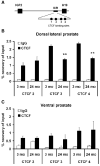Aging and cancer-related loss of insulin-like growth factor 2 imprinting in the mouse and human prostate
- PMID: 18701505
- PMCID: PMC4237281
- DOI: 10.1158/0008-5472.CAN-08-1714
Aging and cancer-related loss of insulin-like growth factor 2 imprinting in the mouse and human prostate
Abstract
Loss of imprinting (LOI) is an epigenetic alteration involving loss of parental origin-specific expression at normally imprinted genes. A LOI for Igf2, a paracrine growth factor, is important in cancer progression. Epigenetic modifications may be altered by environmental factors. However, is not known whether changes in imprinting occur with aging in prostate and other tissues susceptible to cancer development. We found a LOI for Igf2 occurs specifically in the mouse prostate associated with increased Igf2 expression during aging. In older animals, expression of the chromatin insulator protein CTCF and its binding to the Igf2-H19 imprint control region was reduced. Forced down-regulation of CTCF leads to Igf2 LOI. We further show that Igf2 LOI occurs with aging in histologically normal human prostate tissues and that this epigenetic alteration was more extensive in men with associated cancer. This finding may contribute to a postulated field of cancer susceptibility that occurs with aging. Moreover, Igf2 LOI may serve as a marker for the presence of prostate cancer.
Conflict of interest statement
R. Weindruch is a founder of LifeGen Technologies, LLC. The other authors disclosed no potential conflicts of interest.
Figures




References
-
- Sakr WA, Grignon DJ, Crissman JD, et al. High grade prostatic intraepithelial neoplasia (HGPIN) and prostatic adenocarcinoma between the ages of 20–69: an autopsy study of 249 cases. In Vivo. 1994;8:439–43. - PubMed
-
- Malins DC, Johnson PM, Wheeler TM, et al. Age-related radical-induced DNA damage is linked to prostate cancer. Cancer Res. 2001;61:6025–8. - PubMed
-
- Bandyopadhyay D, Medrano EE. The emerging role of epigenetics in cellular and organismal aging. Exp Gerontol. 2003;38:1299–307. - PubMed
-
- Ahuja N, Li Q, Mohan AL, Baylin SB, Issa JP. Aging and DNA methylation in colorectal mucosa and cancer. Cancer Res. 1998;58:5489–94. - PubMed
Publication types
MeSH terms
Substances
Grants and funding
LinkOut - more resources
Full Text Sources
Other Literature Sources
Medical
Molecular Biology Databases
Miscellaneous

